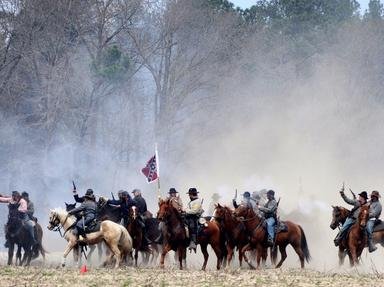Quiz Answer Key and Fun Facts
1. Joseph Hooker, a Union general, used the barn at the Joseph Poffenberger farm at Antietam as his headquarters. The land also served as the jumping off point for the Federal assault south towards Dunker Church. As the day progressed the farm had scores of hungry, wounded, and exhausted Union troops ransack the house and buildings. Much of the contraband was used to feed and care for the hurt and dying. What woman, who later would found the American Red Cross, was there to aid them?
2. The farm of D. R. Miller lies on a little hill just above Hagerstown Pike near Sharpsburg, Maryland. As it turns out, this site happened to be near the exact center of the bloodiest square mile in American military history. On the morning of September 17 of 1862 the house was quickly converted to a field hospital. Also using this site as a base of operations were men hired by "Frank Leslie's Illustrated Newspaper" and "Harper's Weekly". What did men like Alfred Waud, on the scene at the D. R. Miller Farm, contribute to these periodicals?
3. The Alfred Poffenberger farm consisted of a rough log cabin and acres of farmland located in the West Woods beyond the Hagerstown Pike near what would be the Antietam battle field. Very heavy fighting occurred here on September 17, 1862 between the Confederate forces led by Gen. "Stonewall" Jackson and Union forces under Gen. John Sedgwick. The farmstead started the day as a Confederate troop staging area then quickly morphed to a triage station where casualties were given first-aid and loaded on ambulance wagons . A common model of this wagon, utilized by both sides, was the "Wheeling" model developed by a Union general. Who was this military leader who engineered the light, maneuverable model pulled by two horses?
4. In 1862, the farmstead of Samuel Mumma consisted of a large house, a barn, a springhouse, and various outbuildings. By all accounts the house was well furnished and nicely decorated and even contained a library full of leather bound books. The Mumma family had also donated some of their acreage to house the now-famous Dunker Church. Early on the morning of September 17, 1862, what orders were the troops under Confederate Gen. D.H. Hill given to do concerning the Mumma site?
5. The William Roulette farm has, as one of its borders, a lane called the Sunken Road. After the battle of Antietam, also known as Sharpsburg, the road was renamed Bloody Lane due to the amount of corpses piled in the low, rutted path. As fighting surged back and forth at this site, Confederates used one particular Roulette building as a hideaway and makeshift triage area. What was this cooling location?
6. The Henry Piper farm was situated just south of the Sunken Road at Antietam and was home to the Piper family, several slaves, and a free black field hand. The property also boasted the only commercial apple orchard in the area during the summer of 1862. On the afternoon of September 15 of that year, the Pipers were paid a visit by a Confederate general to tell them he was utilizing their house and gardens for his headquarters. Who is this general referred to as "My Old War Horse" by Robert E. Lee and known to others as "Ole Pete"?
7. The farm of Joseph Sherrick had a four story house that, unlike its neighbors, was built directly over a fresh water spring. The site is located between Town Run and Antietam Creek water sources and was the gathering point for exhausted Union soldiers who finally crossed the creek bed under withering fire from the Confederates. On September 19, 1862, Alexander Gardner took some photographs of the aftermath at the farm. Troops from the 22nd Massachusetts had joined their Pennsylvania brethren to scavenge the area of any sustenance. What was the historical nickname of these boys from the 100th Pennsylvania Infantry?
8. The morning of September 15, 1862, saw the farm of John Otto overrun with Confederate soldiers. The farm was located on the banks of the Antietam creek and the men under the command of Confederate Gen. Robert Toombs were fed milk, preserves, bread, and butter by the family's slaves. The men were gathering their strength. After the family left, the Georgia soldiers began defending what river crossing that was later named after the Union general leading the charge on September 17?
9. The Joshua Newcomer farm sat on a rise just above the Middle Bridge that spans Antietam Creek in Maryland. The farm boasted living quarters as well as a grist mill, a saw mill, and a plaster mill that were all powered by the moving water. The road running over the bridge was also a heavily traveled thoroughfare into the local town of Sharpsburg. On the day of the battle, September 17 of 1862, the 2nd U.S. Artillery, under Capt. Tidball, used the Newcomer farm to fire over 1,200 rounds towards the Confederates in order to clear and protect the bridge for the Union. What was the name of the 20-pounder, large rifled field artillery piece used?
10. The Philip Pry farmstead sits on a farm lane more than a mile from where the heavy fighting took place at Antietam, also known as Sharpsburg. It had an impressive house and a large Pennsylvania-style barn. On September 15, 1862, Union Gen. George McClellan took over the house as his headquarters. It was here McClellan leisurely rose for breakfast hours after the start of the battle on the 17th and where, that same afternoon, he saw one of his generals come to die of his wounds. Who was this "rising star" of the U.S. Army, nicknamed "Fighting Dick", who died at the Pry farm?
Source: Author
stephgm67
This quiz was reviewed by FunTrivia editor
bloomsby before going online.
Any errors found in FunTrivia content are routinely corrected through our feedback system.

